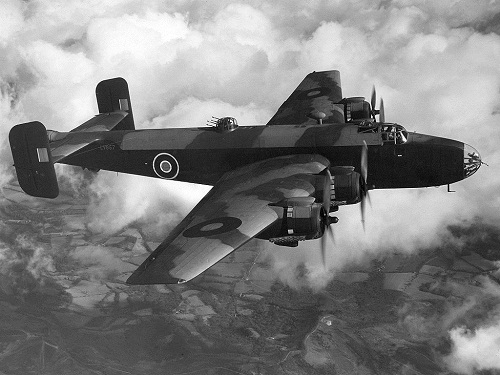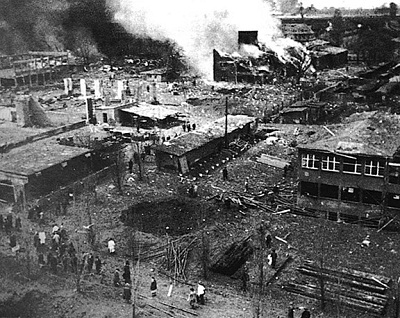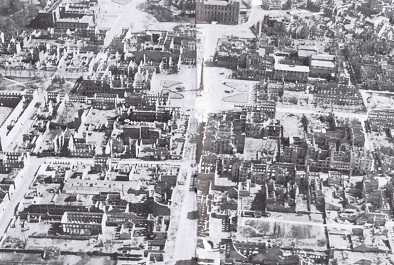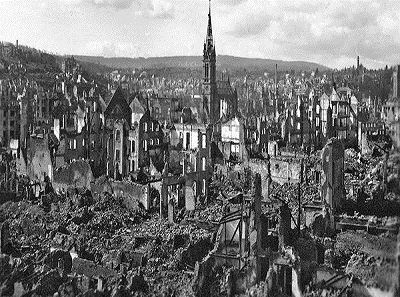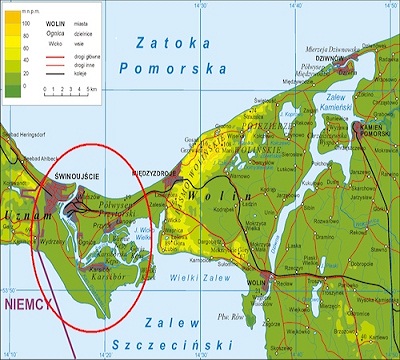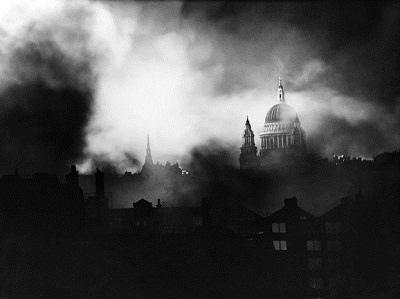WWII (1939-1945) saw various atrocious developments when it came to warfare set in a backdrop of mass destruction of humans due to their ethnicity, religious beliefs and even political loyalty. How Nazi Germany annihilated countless individuals and the way the Allied Forces responded to this aggression can be wrapped up in a story of dominance, mechanization and science.
That same elements at work in the story gave its hands for men’s use and what resulted was the horrible apex brought about by WWII’s bombing campaigns.
Here, we exclude the atomic bombings that happened in Nagasaki and Hiroshima – of course, they are equally terrible and unmatched.
In this list of the top ten most destructive bombings campaigns during WWII, we have the scrupulously planned and often prolonged offensives that burned cities to the ground and destroyed entire urban populace.
Below are what we deemed as WWII’s top ten most destructive bombing campaigns.
10. OSAKA (MARCH-AUGUST 1945) – 10,000 deaths
Throughout WWII, Japan suffered immense loss with their bitter conflict against the Allies, particularly the Americans, culminated in a calamitous nightmare – the atomic bombings of Japanese cities Nagasaki and Hiroshima.
However, before that happened, many Japanese cities were subjected to thorough and calculated bombing campaigns one of which was Osaka, the city hit the hardest. It suffered the loss of about 10,000 civilians between the months of March to August 1945. Of these raids, the first one which happened in March 13 and the early morning of 14 was apparently the most disastrous and intense among the strikes made.
That night, a total of 274 American B-29 heavy bomber airplanes attacked the city leaving desolation in their wake. Napalm and incendiary cluster bombs were released by the low-flying war planes over civilian housing and the bedlam that ensued lasted for three-and-a-half hours.
This said single raid on Osaka left 3,987 deaths while 678 individuals went missing.
9. KASSEL (FEBRUARY 1942-MARCH 1945) – 10,000 deaths
Kassel City located in the Hesse region of west-central Germany was subjected to an ongoing bombing campaign which started as early as 1942 and ended almost at the end of WWII, in 1945. The heaviest and most severe bombing offensive against the city was done by the British on the night of October 22 to 23, 1943.
The British Royal Air Force fanned out a total of 569 bombers over the city’s center and the compact explosion that ensued from the 1,800-tons of bombs released – incendiaries among them – worked out a deadly firestorm resulting to the deaths of at least 10,000 people; the flames from the explosion even burned until seven days after the attack.
Kassel was ardently targeted during WWII because of its valuable military sites. The Fieseler aircraft plant, Henschel tank-making facilities as well as the railway works and engine works were all based there. When the Americans came and liberated Kassel, it only had 50,000 remaining inhabitants; in 1939 the city’s total population had been 236,000.
8. DARMSTADT (SEPTEMBER 1943-FEBRUARY 1944) – 12,300 deaths
another German city, Darmstadt, suffered a series of bombing attacks during WWII, mainly in 1943 and 1944. Among these attacks, the most destructive happened on September 11 and 12, 1944 – the British RAF carried out an intense attack on these days.
Darmstadt was not really a natural bombing target unlike other German cities; it was, after all, not an industrial town but a university one with the Merck chemical factory being the only main industry. In spite of this fact, the city was razed by 226 Lancaster bombers along with 14 Mosquitoes which deliberately spreading their bombs over an area as wide as they can possibly cover with the town’s medieval center as their main target where most of the houses were made of wood.
Almost all the homes were burned down by the fire which resulted from the explosion and an estimated 12,300 deaths resulted from the attack.
The Germans held the raid as the prime example of RAF “terror bombing”.
7. PFORZHEIM (APRIL 1944-MARCH 1945) – 21,200 deaths
Towards the end of WWII, Pforzheim, southwestern Germany town, became a target for a series of bombing campaigns. The principal reason by RAF behind the attacks was that the town was a jeweler’s center and, therefore, had the capability to make precision instruments which the German could use in their war machines – as stated by a report dated June 28, 1944.
nevertheless, the town was not placed in RAF’s list until November of 1944 and the main attack against Pforzheim did not happen until February 1945 causing historian Detlef Siebert to assume that the town was targeted because it was easy to locate and had a medieval town center which was susceptible to fire.
A total of 379 British air crafts hovered the town on the February 23rd attack and what followed was the deadliest 22 minutes – between 19:50 to 20:12 hours, about 83% of the town was totally wiped out and an estimated 17,600 individuals killed along with thousands of others wounded. Pforzheim’s inner city was depopulated and the whole town was ravaged, an effect of the explosions and the burning poisonous phosphorus materials.
6. SWINOUJSCIE (MARCH 12, 1945) – 5,000 to 23,000 deaths
Swinoujscie, the Polish city and port, suffered out-and-out bombing attacks from the hands of the US Air Force during WWII and this happened all within a day.
March 12, 1945 – the fateful day when the then German-controlled city, its population mostly comprised of refugees, was heavily bombed. An estimate of between 5,000 and 23,000 deaths was reported after the terrible occurrence though the exact number is until know unknown as much of eastern Europe at that time was in total chaos. After WWII ended, Poles repopulated the city and it has remained a part of Poland since.
5. LONDON (SEPTEMBER 1940-MAY 1941) – 20,000 deaths
One of the many unforgettable scenes British citizens will never forget from the WWII is the London Blitz – from the German word “blitzkrieg” or “lightning war”.
Germany’s Luftwaffe inflicted planned and continuous offensive attacks which reportedly lasted for 76 consecutive nights and was said to have caused the death of 20,000 individuals. The attacks also caused the destruction of over 1 million homes and the poor areas of the city such as East End distressed terribly during the onslaught.
However, in spite of the devastation inflicted by the Germans such as what happened in London, Britain’s unwavering resolve and unwillingness to be subjected to the demands of Germany’ Third Reich helped change WWII’s course and gave the Allied Forces the launch pad to get back against the enemy in 1942-1945.
As what then British prime Minister Winston Churchill pointed out, “we will never give up” and they never did!
4. BERLIN (1940-1945) – 20,000 to 50,000 deaths
Berlin, Germany’s capital, was subjected to a sustained and strategic bombing attacks by the Allied Forces throughout the duration of WWII.
All in all, Berlin became the target of about 363 air raids between 1940-1945, from British, American and Soviet war planes. The RAFÕs’ policy of solely bombing buildings that have direct military importance was slowly replaced by their new strategy of “area bombing” which included attacks against civilian centers and housing. Civilian deaths was not the aim of this new strategy yet this result was inevitable.
Between 20,000 to 50,000 deaths resulted in the attacks against Berlin during WWII and countless others were left homeless.
3. DRESDEN (OCTOBER 1944-APRIL 1945) – 25,000 deaths
Dresden is Germany’s seventh biggest city during the WWII era and was a vital industrial center at that time that it became the target and was subjected to one of the most severe bombing attacks throughout war history.
the most intense period of these attacks against Dresden happened in February 13 to 15, 1945; about 1300 bombers from the RAF and USAAF combined dropped over 3,900 tones of firebombs and high explosives over the besieged city.
About fifteen square miles of the city’s center was completely destroyed by the destructive firestorm caused by the explosives and the hot winds drove the people to their homes in an attempt to save themselves but turned out to be their death trap.
The death toll released by the Nazi-controlled German press in 1945 was as high as 200,000. However, following estimates which the local authorities supported placed the figure at 25,000 – so much lower than the first estimate but still so many lives lost.
2. HAMBURG (SEPTEMBER 1939-APRIL 1945) – 42,600 deaths
Hamburg, just like Berlin, experienced extensive bombing raids throughout WWII. The city was a critical attack point for the Allied Forces because it was a chief port of the country, an industrial center plus it was the site of various major German shipyards as well as U-boat pens.
The most intense bombing campaign against the city was done by the combined forces of the US and the British last week of July 1943. The campaign dubbed Operation Gomorrah almost wiped out the whole city from the map. Because of the severity of the bomb blasts which went on for eight days and seven nights, it resulted to a feared firestorm that burned down over eight square miles of the city to ashes.
About 3,000 crafts took part in the operation and a total of 9,000 tons of bombs were used. 42,600 individuals were left dead while 37,000 got wounded. It was also estimated that about 1,000,000 civilians fled from the city.
The scale and the force of the operation was something mainland Europe had not witnessed before and had not seen again ever since.
1. TOKYO (NOVEMBER 1944-AUGUST 1945) – over 100,000 deaths
USAAF started bombing Japan on a large, strategic scale November 1944 and continued on until Japan surrendered on August 15, 1945.
The US did a minor bombing operation against Japan’s capital on April 1942 – it boosted the American Army’s morale but it was not until two years later that they really did a full-scale and continuous attack.
When the B-29 Super Fortress came into being, US Army used it extensively over Japan, most specifically over Tokyo. As a matter of fact, almost 90% of the bombs dropped in Japan’s capital were done by B-29s.
Of all the operations done against the city, the most intense happened in March 9-10, 1945. It was dubbed Operation Meetinghouse. This attack is considered the single most destructive bombing campaign ever.
About 1,700 tons of bombs were dropped into the city which destroyed 286,358 buildings and killed over 100,000 civilians with the explosions and the resulting firestorms.
If you add the 1,000,000 injured during the event, you could picture out how devastating and terrible those nights were in 1945; not just those but all those nights civilians had to crouch in fear for their lives as WWII raged on all around them.
